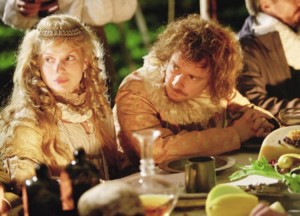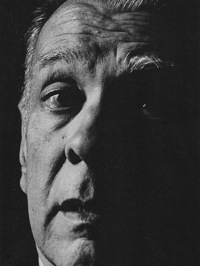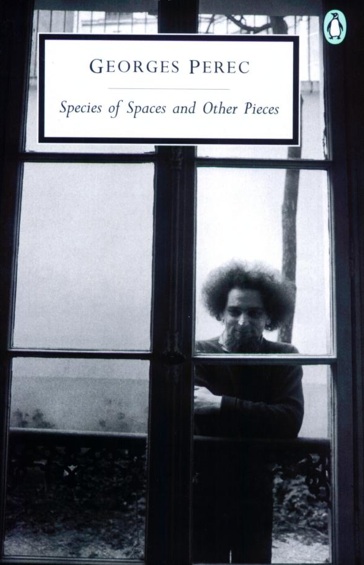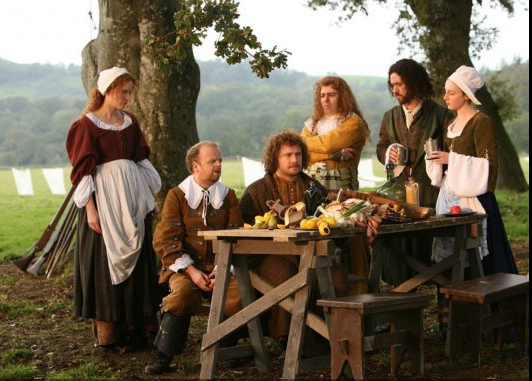Peter Greenaway: Film is Dead; Long Live Cinematic, Multimedia Art
posted March 2, 2013 1 Comment
![]()
 Driving a long way in a car, in blistering heat, isn’t so bad if you have efficient air conditioning and diverting podcasts to catch up on. What could be better than to be prompted to wonder: “Is cinema dead?”
Driving a long way in a car, in blistering heat, isn’t so bad if you have efficient air conditioning and diverting podcasts to catch up on. What could be better than to be prompted to wonder: “Is cinema dead?”
Auteur provocateur, Peter Greenaway, asserts as much, or at least that film in on death’s door. He goes so far as to propose that it has been largely moribund – because more literary than cinematic – since sound came into the movies, if not earlier.
During the last decade, Greenaway has largely opted to work in multimedia contexts, seeking to expand methods he used in his galvanizing films, but which he now believes he can better deploy in works that combine film and other media.
The podcast that accompanied me down a long country highway was one from the BBC’s excellent Night Waves. It aired the interview with Greenaway way back in March 2010. Primarily, he discussed his 2007 film, Nightwatching, which concerns Dutch artist Rembrandt van Rijn’s creation of his renowned canvas, “The Night Watch.” In that work, Rembrandt portrayed a group of Amsterdam militiamen, who commissioned the painting. Greenaway suggested that for reasons known only to Rembrandt, the canvas is encoded with some damning pictorial statements about the militiamen.
Art critics have long pondered the painting’s mysteries, asking, essentially, what is going on in it? For Greenaway (who studied art for four years at Walthamstow Art School, before transitioning to filmmaking), those conundrums and his interpretation of them had just brought him back to the big screen for the first time in a decade. From Rembrandt’s canvas he had made what his BBC interviewer, Matthew Sweet, called “a conspiracy thriller, or as near as you can get if you reject the conventions of narrative cinema.”
In the interview, Greenway said he had sought to find a theory that would explain all the conundrums that have baffled art critics. Such a theory would need to explain, among other things, why the artist ended his life in poverty after being a rich man – and, Greenaway said, nothing called out more for an explanation than “one singular curiosity about the painting: Right in the middle, there’s an adolescent firing a gun. Now, that seems a crazy thing to do in a great, crowded painting of 34 people.”If Greenaway is correct, the future of his career and of moving image forms, in general, will pose plenty of challenges to archivists tasked with preserving them.
As Greenaway’s work commonly is, Nightwatching is extremely “painterly”: his screens are, Sweet suggested, like “vast, highly composed series of tableaux.” Early in his career, that characteristic of his work reaped an “unlikely outcome,” Sweet suggested: He became a favored recipient of funding from government bodies that, from the beginning of Margaret Thatcher’s rise to power in 1970, supported large-scale pictorialist works like his – “art cinema at its best.”
Greenaway’s specific inspirations had been painting and British film’s early tradition of pictorialist rather than narrative film. “That tradition,” said Sweet, “was attacked and discredited by modernists, really, who loved the slashy editing in Russian cinema and the angular lighting in German films from the UFA studio.”
So Sweet asked Greenaway: Is your cinema a form of “restoration”?

But, Sweet proposed, “it’s not just a question of artifice, is it? It’s a question of this attack upon the image, the cutting of the image, the violent action upon the image that modernism encouraged in filmmakers in the teens and 20s. And that kind of cinema became absolutely orthodox; and when I look at your films, I feel that I’m looking at something that could almost come from an alternative world in which those sorts of approaches to cinema never took root.”
Well, replied Greenaway, D. W. Griffiths introduced narrative into cinema, which made him a great hero of American film; “but I think he’s the curse and not the blessing. Cinema really is a very, very poor narrative medium.” An odd thing to say? No, he said: “Cinema acknowledges this, because it has no, or very little, autonomy. Every film you’ve ever seen is text-based, and owes its origins to the bookshop.”
Harry Potter, Lord of the Rings... Practically everybody from Lars van Trier, to Almodovar, to Godard, – “all their works, essentially, begin in a literary phenomenon” – specifically, literary narrative. (For Greenaway, this has been a much-worked riff before 2010 and since.)

Film, Greenaway contended, “has so many ways to portray its knowledge; let’s create a primary, visually alive, visually supporting, visually autonomous phenomenon, which everybody argued for, certainly in places like France and Belgium, in 1910. … But in a curious way, we’ve ended up with a sort of boring bed-time-for-adults, illustrated, third-rate novel, which really is no way to support literature, and certainly is no way to support cinema.”

Sweet asked: Did cinema, then, go wrong in about 1902, with “that little film about the train robbery”?
At least with the advent of sound in film, replied Greenaway. That, he suggested, “meant that sophistication about reading images and understanding what the images were doing disappeared out the window.”
For Nightwatching, Greenaway wanted a “guy next door” Rembrandt who had mundane worries like anyone cast. With that in mind, he cast Martin Freeman from the original, British The Office as the artist. (Greenaway said he did watch some of the series.) Nightwatching premiered in 2007, but wasn’t released in British cinemas until the time of the interview.
Greenaway calls films like Nightwatching “postcinematic.” He has concentrated on such works since his The Pillow Book of 1996: “I think we’ve all agreed now that European cinema is virtually a dead duck. There’s nobody left now, and even the audiences seem to be fast disappearing. I would stretch and organize that a bit further, and make I suppose the deeply provocative statement, in a sense, that cinema is basically finished. We’ve now moved on to all sorts of new ways to empower the human imagination, and that basically conventional, old-fashioned, narrative, psychological drama – cinema – really cannot satisfy now those two big buzz words, one of which is multimedia, and the other, interactivity.”
If he is correct, the future of Greenaway’s career and of moving image forms, in general, will pose plenty of challenges to archivists tasked with preserving them.
Greenaway curates many exhibitions and makes opera and theater, “so the attack or the delight, or the excitement of examining a whole sphere of visual literacy is at my finger tips, and I want to be able to explore this for as long as I can.”
His projects of this kind are now several. The Tulse Luper Suitcases, from 2003, comprised a website, two books, three innovative feature films, and 92 Flash-based “suitcase” games – and, later, two more film recombinations of the three earlier films.
Nightwatching was the first of several films he plans to make about artists and art works. (He made a film about Nightwatching called Rembrandt’s J’Accuse, in 2008).
Some of Greenaway’s project recall 60s happenings, like his 2005 performance as a “VJ,” backed by DJ Radar, at an art-club evening in Amsterdam. There, Greenaway mixed and projected live 92 of his Tulse Luper stories with laser controlled touchscreen onto 12 screens. He has been doing similar things with famous paintings, such as “The Last Supper.” increasingly in art museums, with a mixed reception.
But he has also made more films on similar subjects. Last year’s Goltzius and the Pelican Company tells of Hendrik Goltzius, a 16th-century Dutch painter and engraver of Old Testament erotica – sic! Another, on Hieronymus Bosch, presumably grand, ghoulish, and cautionary, is expected in 2016.
For Greenaway, such works are the way forward. The “laptop generation,” he observes, exhibits “an enormous amount of excitement and fascination with the world and its art and culture.” Fortunately so, he says, because “cinema necessarily has to change. It has to reorganize itself, and I suppose for the last 10 years, I’ve been investigating the different ways to continually excite and empower the imagination, which I’m afraid don’t relate any more to the cinema on the corner of the high street.”
Sweet asked the obvious question: “If the medium is dead, why have you decided to return to its cause?”
“Because,” said Greenaway, “I’m a stupid old fossil, and because I really love cinema language. I think cinema is wasted on cinema. The language is far more powerful than the uses to which we put it.”
– Peter Monaghan

Previous Post: Video of the Day: Sing and Sling
Next Post: Preserving Exemplary American Films







It sounds to me like he rather hates film other than his own.